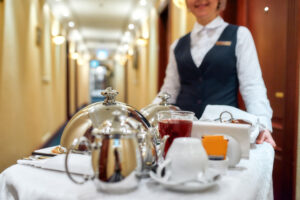Why Hotels Should Be Saying No to Noise Makers

Hotel housekeepers are more likely to be harassed or assaulted due to the isolated nature of their jobs, as they are separated from the rest of their teams and are often required to work alone. Many hotel brands have made a commitment to providing employees with safety buttons/panic buttons as a part of the 5-star promise. In addition, some cities and states have passed hotel panic button laws that provide requirements and deadlines by which hotels should provide staff with safety devices. There are a few types of employee safety devices/panic button systems on the market that hotels can choose from, including full system panic buttons, mobile panic buttons and some hotels are opting to purchase noise makers. But not all of these employee safety devices are created equally, nor do they all fit panic button legal requirements and not all are effective at keeping employees safe.
Can You Put a Price on Employee Safety?
Noise makers are devices that when pressed emit an ear-piercing sound that could possibly capture the attention of those within close proximity. They produce sounds of up to 130 decibels, that is substantially loud when compared to the average speech of around 55 decibels. But noise maker devices do not have the ability to alert hotel security or to provide the location of the employee in distress and can be drowned out by television noise and cleaning equipment like vacuums. The loud noise could also cause an assailant to become more aggressive in an attempt to silence the alarm.
Noise makers cost significantly less when compared to full system panic buttons and mobile panic buttons, which costs between $5000 and $10,000 respectively and could include maintenance charges as well. Noise makers generally cost between $15-20 per device, but they are not as effective at keeping employees safe as other workplace safety devices. While noise makers may be attractive to hotels due to their low cost, their inability to send emergency alerts to security personnel or to provide precise location details should be a deterrent for hotels.
Noise Maker Disadvantages
- Noise makers do not send emergency alerts or provide location details to hotel security personnel.
- Noise makers can be drowned out by television noise or cleaning equipment like vacuums.
- Building materials such as concrete floors and ceilings reduce sound by as much as 70 decibels.
- Drywall and other construction can also reduce sound by as much as 40 decimals.
Hotel Panic Button Requirements
Many cities and states have passed hotel panic button laws and have set specific guidelines as to what constitutes as a panic button device. Once activated, a panic button device should have the ability to provide precise location information down to the exact floor and room number and as the location changes, panic button devices should send updates in real time. This allows responders to locate the distressed employee within seconds or minutes of an emergency alert. Steps should also be taken to ensure that hotel panic buttons do not accidentally send emergency alerts, most panic button systems require employees to hold the device for seconds for an emergency alert to be activated.
Most Cities/ States Panic Button Requirements
Hotel panic button requirements differ depending on the city or state, but most have similar requirements as to what constitutes as a panic button device.
- Panic button devices should be easily activated by a single action like a push, pull or tap. They must provide a sustained signal without delays caused by entering passwords or waiting for the system to turn on.
- When panic buttons are activated, the signal is effective for the circumstances (e.g., designated personnel will be able to detect it regardless of their location and distinguish it from other audible or visual alarms and noise from vacuum cleaners and other sources.)
- Panic button devices should be designed to summon immediate assistance and enable responders to accurately provide reliable locations down to room-level accuracy of where the distress signal originated.
- Devices should consistently work in all locations, on all shifts and the activation of one device should not obscure the activation of other devices.
- The device should minimize unintentional activation and resist possible disabling by attackers.
Full System vs Mobile Panic Buttons
Full System Panic Buttons
Full system panic buttons require the installation of location beacons in each guest room/area. These panic button systems generally cost $10,000 to implement and can include monthly service and support costs, but once these devices are activated, they identify the location down to the precise floor and room number of the distress signal. These panic button devices also have the ability to send out a silent alarm that cannot be heard by the assailant and can be configured to send emergency alerts to predetermined emergency personnel or law enforcement.
Key Advantages
- Panic buttons can be configured to send emergency alerts to predetermined emergency contacts or to local authorities.
- Panic buttons transmit locations down to the precise floor and room number where the distress signal originated.
- Information is sent in real time and is updated if the employee in distress changes location.
Mobile Panic Buttons
Mobile panic button systems require the download of a panic button app to mobile devices. When mobile panic buttons are pressed, the device sends out the employee information as well as the precise location of the emergency to hotel security personnel. Most mobile panic buttons cost around $5000 to implement, other options require no money at purchase but would require a monthly service fee. These workplace safety devices enable one push activation and can be configured to alert hotel security personnel or law enforcement.
Key Advantages
- Mobile panic button systems support two-way communication.
- Mobile panic buttons enable one push activation, that can be configured to alert hotel security personnel as well as local authorities.
- Devices can be installed using existing Wi-Fi- infrastructure.
- Mobile panic buttons utilize 4G technology to detect location and provide real time alerts.
Hotels Need to Make the Right Choice
Choosing the right hotel panic button system is an investment into the safety of hotel employees and hotels cannot put a price on their most valuable asset. Major hotel brands also require panic button systems to meet their brand standard requirements and most of these standards align with legal requirements. Hotel brands have an expectation that panic buttons have reliable location ability to 100% room level accuracy and offers coverage not only in guest rooms but also on guest floors, in public bathrooms and in hotel spas. Hotels can meet these requirements with full system and mobile panic buttons, but noise makers fall short and could end up costing hotels more than money, it has the potential to cost lives.




